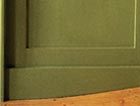Restoring a Georgian townhouse
In the first of a new series, William Palin describes the principles behind the restoration of his 1717 Georgian town house


At Christmas, my grandmother, visiting my newly restored Spitalfields town house, complained of feeling seasick. It was not the champagne, but rather my dogged determination to retain the quality of crookedness that defines these old town houses, even when I had to reconstruct whole rooms of panelling that had been stripped out long ago. Let us face it, it is an odd thing to do, but it is the right approach with a house of this sort.
Any would-be straightener should beware — ironing out these oddities can be damaging to both the structure and character of a building. There is a fine line between re-establishing the dignity, proportion and symmetry of a panelled room and losing the delightful eccentricities which give the house its sense of living history. So, when I embarked on the restoration of my 18th-century home in east London, I decided, often to the amusement and puzzlement of builders, to keep as much as possible of the building's acquired crookedness.
After all, these early-18th-century Spitalfields houses, often built with shallow foundations set in poor ground, have only survived because of their ability to change shape (old buildings like these, with brick and wood frames, bedded on lime-based mortars, are remarkably flexible). The result, in my house of 1717, is that in one room the fall from front to back is 10 inches and, in another (pictured), the boards rise up in one corner to form a hill from which children can launch marbles.
Finding craftsmen who understand your insane desire to jettison the spirit level can prove one of the greatest challenges of a house restoration of this kind. In Spitalfields you have the added pressure of a succession of local enthusiasts peering through window each day. There is certainly no shortage of helpful advice but, equally, word also spreads quickly if you are going about things the wrong way. My joiner was crestfallen after Spitalfields aficionado Dan Cruickshank pointed out a small error in the window architrave. The re-panelling of the ground floor dining room tested my excellent joiner Peter Buckingham to his limits. When he first saw the room he groaned—nothing was straight, floor, walls or ceiling.
Peter opted, sensibly, to put himself in the shoes of his Georgian forebears who would have naturally opted for the simplest method for dealing with the imperfections. The walls were battened out to make them vertical and changes in floor-to-ceiling height were absorbed, where possible, in the skirting and cornice. The result is a room which is both 'correct' and quirky. There is no easy answer to this—it needs to be done on a case-by-case basis—but the result is tremendous.
A sloping floor can have its drawbacks. Unless carefully propped, furniture does tend to migrate across the room. Yet each bump, hollow and trough tells the story of a house over three centuries and without these imperfections the building would be infinitely poorer. For technical information and advice, contact the Society for the Protection of Ancient Buildings (SPAB) (020–7377 1644; www.spab.org.uk). Or contact the Georgian Group (020–7529 8920; www.georgiangroup.org.uk). In Spitalfields: design and technical advice, Jim Howett (020–7375 2757). Peter Buckingham is now based in Scotland (01466 751610).
Sign up for the Country Life Newsletter
Exquisite houses, the beauty of Nature, and how to get the most from your life, straight to your inbox.
Country Life is unlike any other magazine: the only glossy weekly on the newsstand and the only magazine that has been guest-edited by HRH The King not once, but twice. It is a celebration of modern rural life and all its diverse joys and pleasures — that was first published in Queen Victoria's Diamond Jubilee year. Our eclectic mixture of witty and informative content — from the most up-to-date property news and commentary and a coveted glimpse inside some of the UK's best houses and gardens, to gardening, the arts and interior design, written by experts in their field — still cannot be found in print or online, anywhere else.
-
 About time: The fastest and slowest moving housing markets revealed
About time: The fastest and slowest moving housing markets revealedNew research by Zoopla has shown where it's easy to sell and where it will take quite a while to find a buyer.
By Annabel Dixon
-
 Betty is the first dog to scale all of Scotland’s hundreds of mountains and hills
Betty is the first dog to scale all of Scotland’s hundreds of mountains and hillsFewer than 100 people have ever completed Betty's ‘full house’ of Scottish summits — and she was fuelled by more than 800 hard boiled eggs.
By Annunciata Elwes